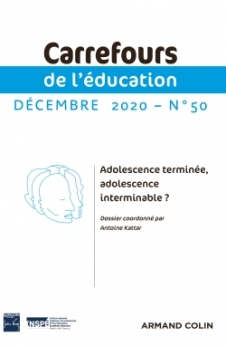
Carrefours de l'éducation n°50 (2/2020)
Pour acheter ce numéro, contactez-nous
Recevez les numéros de l'année en cours et accédez à l'intégralité des articles en ligne.
Depuis 2016 le nombre de mineurs mis en examen sous une qualification terroriste s’est fortement accru en France. Un phénomène sans précédent qui impacte considérablement le travail des juges du tribunal pour enfants et des acteurs en charge du suivi judiciaire des jeunes condamnés. La protection de la jeunesse se trouve sollicitée dans cette oscillation troublante d’une jeunesse à protéger et d’une jeunesse dont il s’agirait brusquement de se protéger. Le dispositif dans lequel j’accueille les jeunes est une alternative à l’incarcération préventive avant le jugement, un dispositif qui tout en créant les conditions d’une observation prolongée exclut l’objectif illusoire de la déradicalisation. Je m’interroge sur la manière dont un enfant se retrouve dans une telle situation, comment en est-il arrivé là ? Par quel nouage singulier cet enfant se trouve dans la relation avec un menteur inconnu mais célèbre, dans le visionnage des scènes horrifiques en soi et d’ordinaire insoutenables pour quiconque, un discours univoque où l’effroi se conjugue à l’apocalyptique d’une réponse ? Dans ce travail clinique l’apparition de la figure du « ça-cri-fils » où le jeune en question se voue à expier la faute commise par un père dévalué constitue un point de traversée violent et définitif.
Since 2016, the number of minors investigated for activities relating to terrorism in France has increased considerably. This unprecedented phenomenon impacts the work of the judges in juvenile courts and of those in charge of the judicial follow-up of convicted youths. Juvenile protection services find themselves called upon to act upon these swings from a youth that needs protection to a youth from which it might suddenly be necessary to protect oneself. I meet young people within a scheme which offers an alternative to incarceration before trial and both creates the conditions for long-term observation and puts paid to the illusions of de-radicalisation. I explore how a child ends up in this situation – how did s/ he get to such a point? What singular link has connected a child to such and such a famous but unknow liar, watching scenes of horror which nobody in the general run of things can stand to watch, bathed in a univocal discourse where dread marries the apocalyptic character of an answer ? During clinical work the emergence of the figure of “sacrifice”, whose French pronunciation allows it to be rendered in an untranslatable pun as “ça-crie-fils” (“its crying out son”)(“fils” is the word for son), which shows the youth deciding to expiate the sins of a debased father, constitutes a violent and definitive transition.